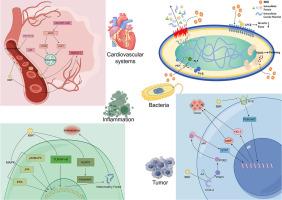Multiple target and regulatory pathways of berberine
IF 8.3
1区 医学
Q1 CHEMISTRY, MEDICINAL
引用次数: 0
Abstract
Background
Berberine (BBR), a widely used monomer in traditional Chinese medicine, well-known for its extensive pharmacological activities against tumors, neurological disorders, and cardiovascular disease. These effects are mediated through the regulation of multiple molecular targets and signaling pathways, including the MAPK, TLR4/NF-κB, PI3K/AKT, and AMPK/mTOR. In addition, BBR demonstrate potent antimicrobial activity by reducing pathogen invasiveness, disrupting biofilms integrity, preventing the formation of macromolecules, and interfering with metabolic processes. More, BBR can modulate the gut microbiome and exhibit an effective treatment for metabolic disorders such as diabetes mellitus.
Purpose
The goal of this review is to present a current summary of the molecular processes that underlie BBR's action, discussing BBR interactions with novel factors, examining current knowledge on BBR side effect and nano-carrier applications, offering new perspective on expanding its therapeutic use. Further is required to identify novel targets of berberine and to investigate its potential for new therapeutic applications.
Methods
The review adhered to the Preferred Reporting Items for Systematic Reviews and Meta-Analyses (PRISMA) guidelines. Data were organized into tabular and narrative formats. Structural formulae of compounds were created using ChemDraw Professional 22.0 software, while botanical information was sourced from the Flora of China (www.iplant.cn). The keyword "Berberine" was used to search databases, including ScienceDirect, PubMed, CNKI, and Web of Science, covering publications from 1970 to 2024. To ensure comprehensive data collection, additional searches were conducted using Connected Papers, Springer Search, Baidu Scholar, Google Scholar, and other databases. Keywords such as "toxicology," "traditional uses," "molecular mechanism," "pharmacology," and "chemical compounds" were applied to further refine and analyze the collected information.
Results
Berberine exerts potent antibacterial, anti-inflammatory, and therapeutic effects in cardiovascular, neurological, metabolic, and tumor-related conditions by modulating key intracellular signaling pathways (e.g., AMPK/mTOR, PI3K/AKT, TLR4/NF-κB). It also impacts gut flora, offering new treatment avenues for gastrointestinal diseases, diabetes, and related renal disorders. Despite its clinical efficacy, berberine’s low oral bioavailability and the complexity of its mechanisms and safety profile highlight the need for further research to fully unlock its therapeutic potential.
Conclusion
This study summarises the methods by which berberine heals a number of prevalent conditions and elaborates on the relationship between berberine and illnesses. Furthermore, it discusses the application of berberine nanofomulations in treating diseases. Future research on berberine should explore its potential in treating rare diseases, mental health disorders, immune conditions, neurodegenerative diseases, metabolic disorders, and cancer, while enhancing drug delivery systems and investigating its epigenetic effects.

小檗碱的多靶点及调控途径
小檗碱(berberine, BBR)是中药中广泛使用的单体,因其对肿瘤、神经系统疾病和心血管疾病具有广泛的药理作用而闻名。这些作用是通过调控多种分子靶点和信号通路介导的,包括MAPK、TLR4/NF-κB、PI3K/AKT和AMPK/mTOR。此外,BBR通过降低病原体侵袭性、破坏生物膜完整性、阻止大分子的形成和干扰代谢过程,显示出强大的抗菌活性。此外,BBR可以调节肠道微生物群,并对代谢紊乱如糖尿病有有效的治疗作用。目的本文综述了BBR作用的分子过程,讨论了BBR与新因子的相互作用,检查了BBR副作用和纳米载体应用的现有知识,为扩大其治疗应用提供了新的视角。需要进一步确定小檗碱的新靶点并研究其在新的治疗应用中的潜力。方法本综述遵循系统评价和荟萃分析首选报告项目(PRISMA)指南。数据被组织成表格和叙述格式。化合物的结构式由ChemDraw Professional 22.0软件生成,植物信息来源于Flora of China (www.iplant.cn)。使用关键词“Berberine”搜索数据库,包括ScienceDirect、PubMed、CNKI和Web of Science,涵盖1970年至2024年的出版物。为了确保全面的数据收集,使用Connected Papers、施普林格Search、百度Scholar、谷歌Scholar和其他数据库进行了额外的搜索。使用“毒理学”、“传统用途”、“分子机制”、“药理学”、“化合物”等关键词对收集到的信息进行进一步细化和分析。结果小檗碱通过调节细胞内关键信号通路(如AMPK/mTOR、PI3K/AKT、TLR4/NF-κB),对心血管、神经、代谢和肿瘤相关疾病具有有效的抗菌、抗炎和治疗作用。它还会影响肠道菌群,为胃肠道疾病、糖尿病和相关肾脏疾病提供新的治疗途径。尽管具有临床疗效,但小檗碱的口服生物利用度低,其机制和安全性的复杂性突出了进一步研究以充分释放其治疗潜力的必要性。结论本研究总结了小檗碱治疗一些常见疾病的方法,并阐述了小檗碱与疾病的关系。并讨论了小檗碱纳米制剂在疾病治疗中的应用。未来对小檗碱的研究应探索其在治疗罕见病、精神健康障碍、免疫疾病、神经退行性疾病、代谢障碍和癌症方面的潜力,同时增强药物传递系统并研究其表观遗传效应。
本文章由计算机程序翻译,如有差异,请以英文原文为准。
求助全文
约1分钟内获得全文
求助全文
来源期刊

Phytomedicine
医学-药学
CiteScore
10.30
自引率
5.10%
发文量
670
审稿时长
91 days
期刊介绍:
Phytomedicine is a therapy-oriented journal that publishes innovative studies on the efficacy, safety, quality, and mechanisms of action of specified plant extracts, phytopharmaceuticals, and their isolated constituents. This includes clinical, pharmacological, pharmacokinetic, and toxicological studies of herbal medicinal products, preparations, and purified compounds with defined and consistent quality, ensuring reproducible pharmacological activity. Founded in 1994, Phytomedicine aims to focus and stimulate research in this field and establish internationally accepted scientific standards for pharmacological studies, proof of clinical efficacy, and safety of phytomedicines.
 求助内容:
求助内容: 应助结果提醒方式:
应助结果提醒方式:


